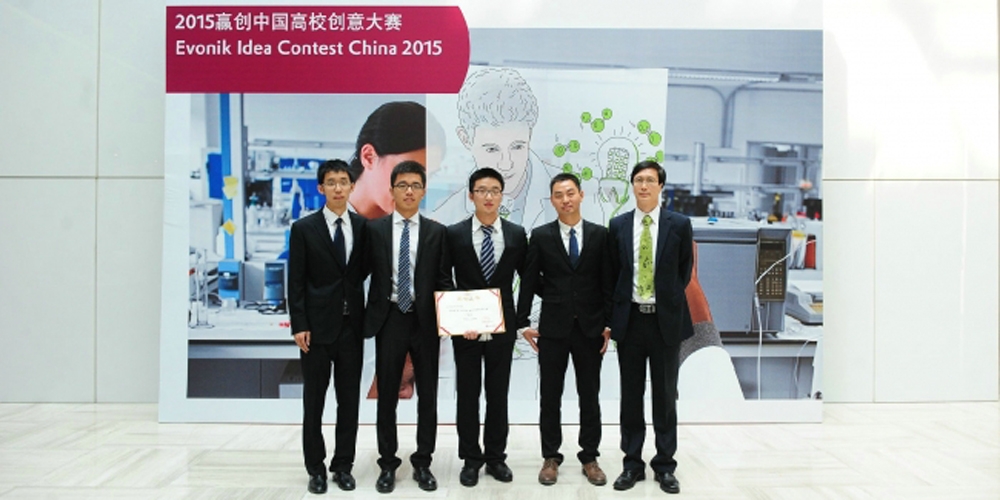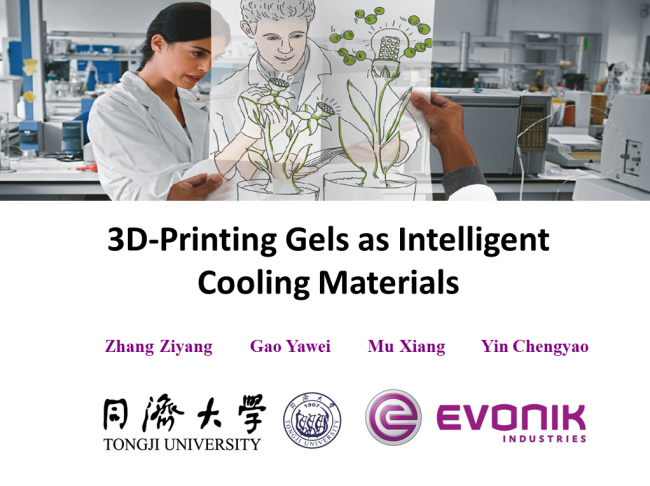On October 13th, the second Evonik Innovation Competitions amongst Chinese Universities was held in the Evonik Great China area, headquartered in Shanghai. The team made up of students from Tongji University entered the finals with the project named “3D-printing Cooling Gel Material”. The representative students who successfully won the final after the excellent project presentations and statements are Zhang ziyang, Gao yawei, and Ying chengyao from Department of Chemistry and Mu xiang from College of Civil Engineering. The vice-president of Evonik Great China area Dr. Chen Baoshu awarded the prize to our students.

This competition sponsored by Evonik Industries is an interdisciplinary scientific innovation event aimed at universities students. In 2014, this competition attracted around 600 students from 65 Universities in China. The competition of this year was titled “If materials could think…intelligent materials provide solutions for green architectures”. The event wanted to encourage participants to provide and describe building solutions where new materials have been used in intelligent green architectures (houses, bridges, tunnels and roads). The sharing of new solution is pivotal for the spreading of ideas in sustainable development. It also stimulates and acknowledges student innovation and creativity. The standards for evaluation are based on originality, technical feasibility, commercial applications, presentations, teamwork and sustainability.
The students who represented Tongji University went through a competitive selection, carried on campus. Initially nine teams signed up,, with more than 30 postgraduate or doctoral students from the Department of Chemistry, the College of Architecture and Urban Planning, the College of Transportation Engineering, the School of Aerospace Engineering and Applied Mechanics, School of Materials Sciences and Engineering, School of Mechanical Engineering, School of Physics Sciences and Engineering, etc., signed up for this competition. The selected candidates from Tongji University were divided into three teams and later joined the 11 teams from Fudan University, Shanghai Jiao Tong University, Tianjin University, etc.. These teams all “survived” the screening of national preliminary due to their competent preparations, and were nominated for the semi-final. Finally, a team from our school led by Zhang Ziyang, and other 4 teams from Sichuan University, Dalian University of Technology, East China University of Science and Technology, and Shanghai Normal University advanced to the final. In the final the students had to sustain an intense, on-the-spot scrutiny and be able to reply efficiently to the various questions. Finally, the scheme “3D-printing Cooling Gel Material” proposed by Zhang Ziyang’s team turned out to be in judges’ good graces and carried off champion while the project put forward by the team from Sichuan University’s team won second place. East China University of Science and Technology won third place, and the remaining two teams got the excellence award.

The achievement of our students was truly remarkable and fruit of great team work, passion and dedication. Throughout preliminary, semi-final and the finals, Zhang Ziyang and his team members consulted an enormous amount of literature, discussed over and over again to improve their scheme, devoted themselves to designing experiments, collecting data, summarizing and analyzing, and actively solicited opinions of teachers from the Department of Chemistry as well as the College of Architecture and Urban Planning. In this competition, four participants advanced their professional knowledge, exploring ways to apply gel material to new fields. During the course of this interdisciplinary exchange, their analytical skills and horizon were broadened, and their abilities were strengthened across-the-board. It is important to remember that our students could not have achieved this outstanding result without the firm support of the School Youth League Committee and the Department of Chemistry and the technical support and experimental guidance provided by the functional nano-composite gel research group, to which those team members belonged.
Translated by May Language Studio
http://news.tongji.edu.cn/classid-10-newsid-48816-t-show.html